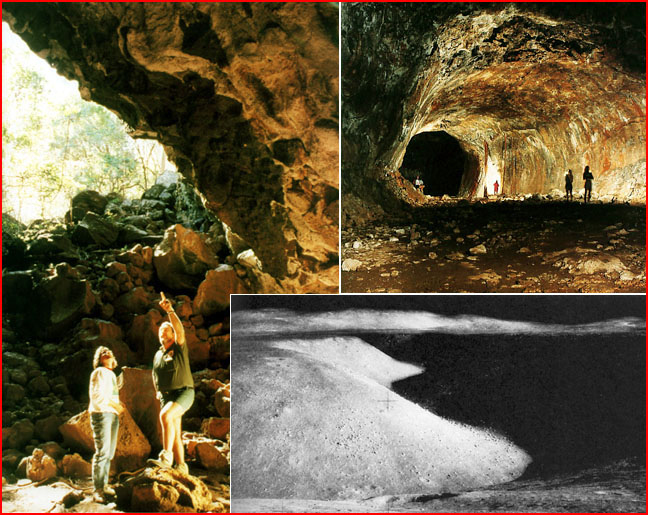|
|
||
 Credit: left: QTTC, rubble from collapsed roof section in Barker Cave Credit, top right: David B. J. Thomae, Barker Cave in Australia Credit, bottom right: NASA/Apollo 15, Hadley's Rille |
||
|
pic of the day Links:
Society for
|
Oct 11, 2004 The lava tube has become the favored explanation for strange channels on most other minor planets and moons. This example of a section of the longest lava tube on Earth is found in Australia and is known as Barker's Cave. It is 35 km from the extinct Undara volcano and measures some 15 metres in height. This section runs for 682 meters. Lava tubes on Earth are formed when a stream of cooling fluid lava builds up levees and forms a crust on top that forms a roofed channel. The enclosed lava loses very little heat and may flow for a large distance before it solidifies. When the eruption ceases, the lava continues to run out at the lower end, leaving an empty tube in the rock. At some later time the roof may collapse leaving sections of open channel. The problem with the lava tube theory of rilles is that the rilles found on other planets and moons show only superficial resemblances to lava tubes on Earth. The larger rilles are kilometers wide, too wide for a rock roof to span. The longest are a thousand times longer than any on Earth. Most rilles have a sinuous V-shaped channel. Neither the collapsed roofs nor the out-flow of lava associated with Earth's lava tubes are seen in the celestial rilles. Perhaps most importantly, the "flow" of rilles on other worlds isn't limited to "downhill" like lava and water-carved channels on Earth. In addition their sinuosity defies all of the rules of channel width and fluid erosion. The bottom right image above is a photograph taken by the Apollo 15 astronauts of the V-shaped Hadley's Rille, described by planetary geologists as a lava tube. There is no sign of lava or rubble from a collapsed roof, and the walls appear to be stratified rock that has been tilted upwards, as if by a blast. In light of the ubiquitous plasma activity in space that has been discovered in the first half-century of the space age, it is time to ask if rilles, too, are caused by electrical interactions. And that question leads to more questions: was there a one-time rille-carving event? Multiple repeated events? Uniform continuous carving? Or will we discover different histories on different worlds that have had different electrical experiences? (Or even on different parts of the same worlds?) Clues to answer these questions may be found in many places. In geology, the paleomagnetic, flora/fauna, and volcanic behavior of the Earth has changed from age to age. We can study the behavior of present-day electrically active bodies such as Io and Titan and comets. We may even find clues in the mytho-historic legend of the Celestial Thunderbolt. |
|
|
Copyright 2004: thunderbolts.info |
||
